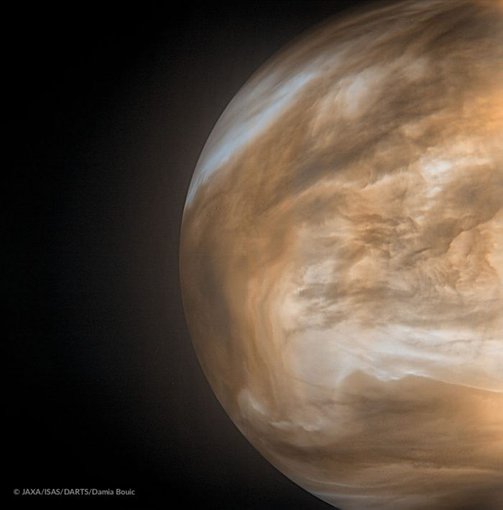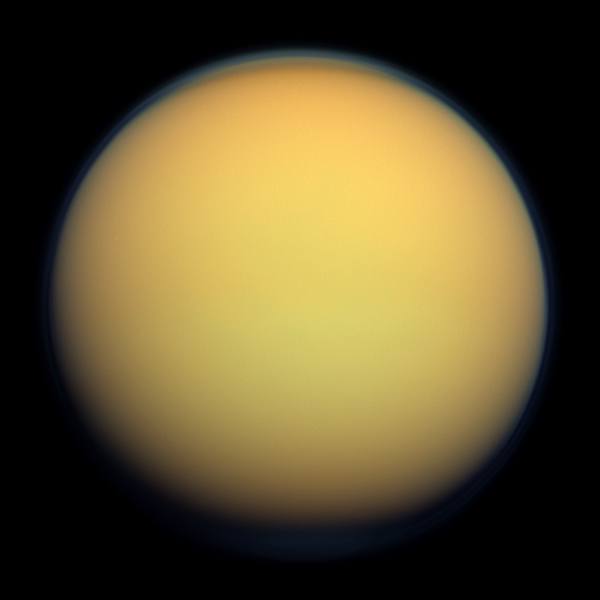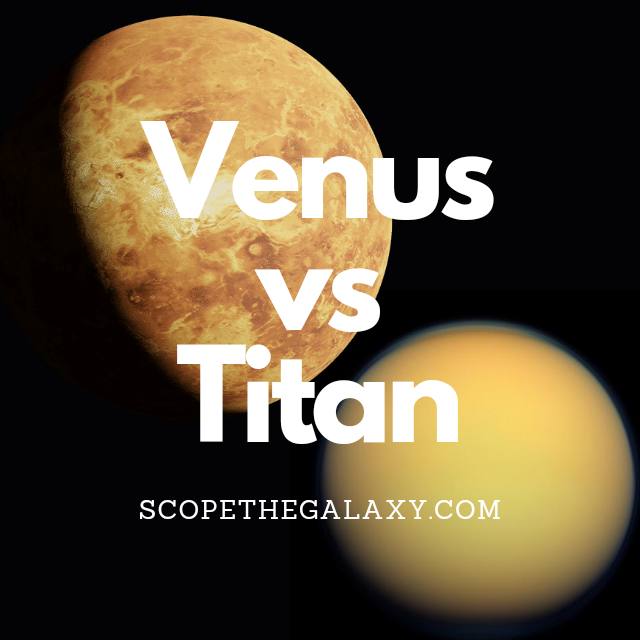*This post may contain affiliate links. This means we may make a commission if you purchase an item using one of our links*
The main differences between Titan and Venus would be that Venus is the 2nd farthest planet from the Sun, is the hottest planet in our solar system, is the brightest celestial entity other than the Sun in our solar system and is more than twice Titan’s diameter whilst Titan is a natural satellite that has a water cycle similar to that of Earth, orbits Saturn and is far colder than Venus as a result.
There are a variety of other differences between these two celestial bodies so continue reading if you want a more detailed breakdown of these differences below.
What Is The Planet Venus?
Table of Contents

Venus is the 2nd closest planet to the Sun and is often regarded as Earth’s sister planet. It’s very close to our Earth in size where its diameter is 12,104km. This is just over 600km less wide than our home planet.
Unlike all the planets further outside the Sun’s orbit, Venus and even mercury have no moons orbiting it. The most probable reason for this is due to its closer proximity to it, which means that smaller objects orbit the Sun as opposed to Venus.
Venus is also the hottest planet in our solar system where its surface temperature is 475 degrees Celsius. This is due to a number of factors, like the thicker atmosphere, close proximity to Sun, the reasons for which have been explained in more detail here.
It’s core is hot too, similar to that of the ice giants and Earth, where it stands at 5,200 degrees Celsius.
As a result of this thicker atmosphere, Venus is also able to reflect a lot more of the light the Sun projects at it, making it both the hottest and brightness planet in our solar system. This is why for the longest time, and even till this day Venus is often referred to as the morning or evening star.
The thicker atmosphere is mostly compromised of carbon dioxide, and thick clouds of sulfuric acid. This does result sulfuric acid rain on the planets surface, which of course is very corrosive.
Being so close to the Sun also mean its orbital cycle is much shorter. It takes Venus 225 days to complete a full cycle, on the contrary a single day is actually longer than this where it takes around 243 days for a full rotation around its axis.
This is partially down to its distance from the Sun and the thick atmosphere surrounding this terrestrial planet. The axial tilt on Venus is also different from the other planets in our solar system where it is practically straight at 3 degrees.
All in all this is certainly one of the most interesting planets in our solar system and in many peoples eyes, could very well have supported life in the past based on how close its shape and size is to that of Earth.
What Is The Moon Titan?

Titan is Saturn’s largest moon and the second biggest moon in the entire solar system, with a diameter of 5,150km. This would make it even larger than the planet Mercury which is only 4,879km, and significantly larger than Pluto also.
As a result, Titan’s gravitaional strength stands at around 1.352 m/s²
It is the only natural satellite in our solar system that is composed similarly to Earth, where it has a thick atmosphere made primarily of nitrogen (95%) along with smaller amounts of methane (5%). It has rivers and lakes on its surface along with a water cycle very similar to that of Earth, where essentially water evaporates and eventually lands on the satellites surface.
Therefore, much like Earth, Titan has a terrestrial based body but, there is a difference in their atmospheric pressure. The pressure on Titan’s surface is around 60% greater than that of Earth’s surface but, it isnt nearly as dense.
Nevertheless, it is still far denser than most other bodies at 1.88 g/cm³. As a result, Titan’s mass is 1.345×10^23 kg.
In regards to its temperature, Titan is on the colder side where it averages around -179 degrees Celsius whilst its core’s temperature is actualluy very cold in comparison to other entities falling between 226 – 526 degrees Celsius.
As Saturn is the 6th farthest planet from the Sun, it will take Titan roughly the same amount of time to orbit the Sun, which would fall around 29.4 years.
It takes Titan 15 days and 22 hours to orbit Saturn. A day is 15 days and 22 hours also as it is tidally locked to the gas giant.
Similarities Between Venus And Titan
Titan and Venus do have their odd few similarities, which in this case includes the below:
- Both have a hotter central core.
- Both have an atmosphere and a rocky surface.
- Both are a spherical shape.
- Both have no rings surrounding them.
- Both have no other celestial bodies orbiting them.
Differences Between Venus And Titan
In regards to the differences, they include the following:
- Venus is the bigger of the two with a diameter of 12,104km compared to Titan’s 5,150km.
- Titan’s atmosphere is composed of 95% nitrogen and 5% methane whilst Venus’ atmosphere is composed of 96% carbon dioxide and 3.5% molecular nitrogen.
- Titan’s atmosphere is 4 times as thick as Earth’s whilst Venus’ atmosphere is 90 times thicker than Earth’s.
- Venus is the brightest entity in our solar system due to its atmosphere and reflective nature.
- Venus is far hotter than Titan with an average temperature of 475 degrees Celsius whilst Titan has an average temperature of -179 degrees Celsius.
- In regards to core temperatures, Titan’s is between 226 -526 degrees Celsius whereas Venus’ is 5,200 degrees Celsius.
- A day on Titan takes 15 days and 22 hours whilst a Venus day takes 243 days to complete.
- Titan completes an orbit around the Sun in 29.4 years whilst Venus completes its orbit in 225 days.
- Venus orbits the Sun in a circular pattern whilst Titan orbits Saturn in an elliptical pattern.
- Venus’ gravitational strength is 8.87 m/s² whilst Titan’s is 1.352 m/s².
- Venus’ density is 5.24 g/cm³ whilst Titan’s density 1.88 g/cm³.
- Titan’s axial tilt is 27 degrees whilst Venus’ axial tilt is 3 degrees.
- Titan is a pale yellow color whilst Venus is yellowy white color.
- Titan has a water cycle like Earth with rivers and lakes present on its surface whilst Venus’ surface is full of volcanos whilst its sulfuric acid rain is unable to reach the surface due to the planets extreme heat.
Summary
Although Venus and Titan do have a somewhat similar composition from the rocky exterior and thick atmosphere but vary significantly in a variety of other ways.
Whether it be their differences in size, temperature, luminosity, gravity and even the time it takes to complete an orbit around the Sun so, despite their terrestrial nature both entities do fall under different brackets and as a result very distinct entities from one another.

